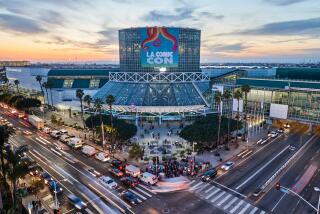Will Comic-Con leave San Diego? Other cities are making pitches

- Share via
Comic-Con International, San Diego’s lucrative four-day convergence of costumes and commerce, may be ready for a change of scenery.
With an expansion of San Diego’s convention center stalled, other Southern California convention center operators are making a play to lure away that city’s biggest and most profitable convention.
Organizers of the annual gathering of more than 130,000 comic book and pop culture fans are now considering suitors, including Los Angeles and Anaheim, as they weigh the option of signing a contract to stay in San Diego after Comic-Con’s convention next year or finding a new home.
“The proposals we’ve received are pretty amazing,” said David Glanzer, a spokesman for Comic-Con International. “It’s not an easy decision.”
Comic-Con has been held in San Diego for more than 40 years but has outgrown the 615,700 square feet of exhibition space at the waterfront convention center. The event is so popular that tickets are usually sold out within hours after going on sale.
To help keep Comic-Con and other trade shows in San Diego, the city approved a plan in 2011 to expand the convention center by 225,000 square feet of exhibit space, plus 101,000 square feet of meeting space and an 80,000-square-foot ballroom.
But the $520-million expansion lost momentum last summer when a state appeals court ruled against a financing plan that would allow hotels around the convention center — instead of voters — to decide on a tax increase to pay for the project. San Diego Mayor Kevin Faulconer has vowed to find another way to finance the expansion.
Still, Faulconer faces another problem. The San Diego Chargers are pushing to have a new stadium built several blocks from the existing convention center, in a combined stadium and convention center expansion site. Without a new stadium, the Chargers might move to Los Angeles.
But the politically powerful hotel industry opposes the Chargers plan for a combination facility. In the past, Comic-Con officials have sided with the hoteliers in favoring an expansion that is contiguous, not several blocks away.
San Diego convention officials are not yet panicking.
“I don’t think any of the venues that are trying to compete for Comic-Con are going to offer anything as good as San Diego,” said Steven Johnson, a spokesman for the San Diego Convention Center Corp. “Attendees have grown to love San Diego as a destination.”
Although Comic-Con never made the expansion a condition for staying in San Diego, Johnson said it would have given the city more leverage.
“If we had an expansion, we would be sitting in a much more comfortable position,” he said.
For San Diego, Comic-Con is big business. Last year, its 130,000 attendees accounted for 60,960 room nights and generated $177.8 million for the local economy.
Since 1970, Comic-Con has drawn 1.8 million people, who, if they linked arms, would stretch from San Diego to beyond Chicago, according to local boosters.
But attendance numbers and cash flow aren’t the only benefits to the city. Comic-Con is a summer party where the downtown is invaded by pop culture fans in zany costumes. To get into the mood, Mayor Faulconer and then-City Council President Todd Gloria arrived last summer by zip line; the downtown had been unofficially renamed Gotham City.
“Comic-Con is another opportunity for San Diego to show the world what San Diego is really about: innovation and creativity,” said Mark Cafferty, president and chief executive of the San Diego Regional Economic Development Corp.
Joe Terzi, president and chief executive of the San Diego Tourism Authority, said he believes Comic-Con will soon, maybe within a month, sign a deal to stay in San Diego for 2017 and 2018, based on an agreement with local hotels to devote their meeting space for Comic-Con activities.
“For us, Comic-Con is our Super Bowl,” Terzi said. “We’re very committed to Comic-Con.”
Convention organizers say they want to stay in Southern California, which would make Los Angeles and Anaheim the top candidates for luring Comic-Con away. Anaheim may be the most attractive suitor because it can offer the largest exhibit hall space in the region — 815,000 square feet — plus proximity to Disneyland and Disney’s California Adventure Park. In addition, the Anaheim Convention Center already hosts a smaller gathering organized by Comic-Con International known as Wondercon.
Representatives for the Anaheim/Orange County Visitor and Convention Bureau declined to discuss any efforts to attract Comic-Con, but they pointed out that construction recently began to add 200,000 square feet to the convention center. Plus, the facility last week launched a $2.5-million upgrade to provide free Wi-Fi throughout the center.
Nine new hotels have been built or are under construction within a mile of the Anaheim Convention Center, adding up to 1,500 new hotel rooms.
Los Angeles has long pined for Comic-Con. That was highlighted in 2010 when Comic-Con last considered moving out of San Diego. The Los Angeles visitor’s bureau launched a website that touted the city’s assets as a convention host.
Los Angeles has promoted its proximity to the Hollywood studios that film many of the movies and television shows that are featured at Comic-Con. Plus, the convention center is now adjacent to L.A. Live, a commercial district brimming with clubs, restaurants and shops.
“There’s no better way to celebrate comic book and sci-fi heroes, villains, artists, writers, creators and actors than Comic-Con,” said Ernest Wooden Jr., president and chief executive of the Los Angeles Tourism and Convention Board. “And I believe there’s no better place than Los Angeles for a home away from home for this celebration as L.A. has the hospitality and convention infrastructure to support the show.”
The city’s largest convention is the Electronic Entertainment Expo, or E3, a gathering of video game exhibitors and others that brings nearly 50,000 attendees to the convention center.
But Los Angeles’ biggest shortfall in drawing bigger conventions is a shortage of hotel rooms within walking distance of its convention center.
Los Angeles has fewer than 5,000 hotel rooms within a mile of the convention center, with an additional 2,000 or so rooms under construction. Meanwhile, Anaheim has more than 13,000 hotel rooms within a mile of the convention center. San Diego has about 11,000 rooms within walking distance.
More to Read
Inside the business of entertainment
The Wide Shot brings you news, analysis and insights on everything from streaming wars to production — and what it all means for the future.
You may occasionally receive promotional content from the Los Angeles Times.











